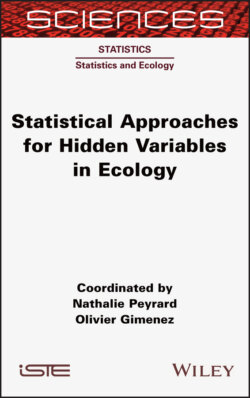Читать книгу Statistical Approaches for Hidden Variables in Ecology - Nathalie Peyrard - Страница 25
1.2.2. Activity reconstruction model 1.2.2.1. Overview
ОглавлениеAs we indicated earlier, an individual alternates between different activities, and these are reflected in different modes of movement. For example, an individual who is looking for food will move slowly, with frequent changes of direction as potential food sources are detected. An individual traveling back to the colony, on the other hand, will travel relatively quickly and in a relatively straight line.
Subjacent (hidden) activities may be reconstructed by analyzing a trajectory, using a model that connects activities and movement. In this case, the observations y0:n = (y0, . . . , yn) are measures of a metric, which is presumed to be affected by an animal’s activity (typically, this metric represents speed; other examples are discussed in the following section). Taking 0 ≤ t ≤ n, zt is used to represent the unobserved activity of an individual at an instant t. This activity is encoded as an integer between 1 and J, where J is a known integer, representing the number of expected activities. Observations and hidden activities are considered as realizations of random variables. Let Z := (Z0, . . . , Zn) be the series of hidden states (subjacent activities) and Y := (Y0, . . . , Yn) the series of movement measurements.
Figure 1.2. Figure extracted from Figure 4 in Lopez et al. (2015). The black line shows a precise recording of the movements of an elephant seal. The green line was obtained by filtering positions recorded using the Argos system, and the purple line shows a smoothed version of the same data. The trajectory reconstructed using smoothing corresponds more closely to the reference data than the version obtained by filtering. For a color version of this figure, see www.iste.co.uk/peyrard/ecology.zip
Using a classic activity reconstruction approach, the sequence Z is modeled by a Markov chain, that is, the series of random variables Zt verifies the Markov property; in other terms, for any series of integers z0:t with values in {1, . . . , J}i+1:
Furthermore, if we consider that this probability of transition is independent of the instant t, the Markov chain is said to be homogeneous1.
The model draws on the idea that the distribution of Yt is dependent on the activity. The modeler must, therefore, specify the distribution of Yt|{Zt = j}. This specification is generally carried out using a parametric distribution (typically a normal distribution). Activity identification is based on the ways in which the parameters of this distribution change (the mean and variance change as the activity changes).
The full model is formulated as follows:
From top to bottom, these three equations define:
– The initial distribution: this the probability distribution for the first activity, and is thus a vector of probabilities ν0 = (ν0(1), . . . , ν0(J)). In the common case where only one trajectory is observed, the initial distribution is taken to be known, or equal to a uniform distribution over {1, . . . , J}.
– The transition distribution: in the case of a homogeneous Markov chain, the transition distribution is fully characterized by the matrix Π, of size J × J, of which each line is a probability vector.
– The emission distribution: the observation is taken to be a random variable, the distribution of which depends, via these parameters, on the activity. The nature of the distribution depends on the nature of the observations. Note that observations are considered to be independent, conditionally to Z.
This model is shown in the graphical form in Figure 1.3.
